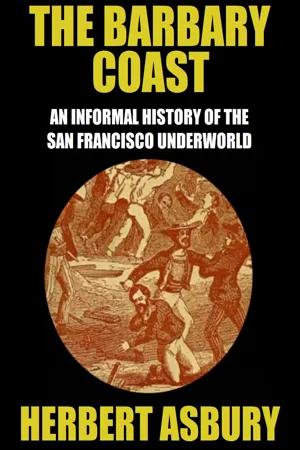
- 431 pages
- English
- ePUB (mobile friendly)
- Available on iOS & Android
About this book
The history of the Barbary Coast properly begins with the gold rush to California in 1849. Owing almost entirely to the influx of gold-seekers and the horde of gamblers, thieves, harlots, politicians, and other felonious parasites who battened upon them, there arose a unique criminal district that for almost seventy years was the scene of more viciousness and depravity, but which at the same time possessed more glamour, than any other area of vice and iniquity on the American continent. The Barbary Coast is the chronicle of the birth of San Francisco. From all over the world practitioners of every vice stampeded for the blood and money of the gold fields. Gambling dens ran all day including Sundays. From noon to noon houses of prostitution offered girls of every age and race. This is the story of the banditry, opium bouts, tong wars, and corruption, from the eureka at Sutter's Mill until the last bagnio closed its doors seventy years later.
Frequently asked questions
- Essential is ideal for learners and professionals who enjoy exploring a wide range of subjects. Access the Essential Library with 800,000+ trusted titles and best-sellers across business, personal growth, and the humanities. Includes unlimited reading time and Standard Read Aloud voice.
- Complete: Perfect for advanced learners and researchers needing full, unrestricted access. Unlock 1.4M+ books across hundreds of subjects, including academic and specialized titles. The Complete Plan also includes advanced features like Premium Read Aloud and Research Assistant.
Please note we cannot support devices running on iOS 13 and Android 7 or earlier. Learn more about using the app.
Information
Table of contents
- Table of Contents
- THE BARBARY COAST
- COPYRIGHT NOTE
- DEDICATION
- INTRODUCTION, by Eileen Hammond
- AUTHOR’S NOTE
- CHAPTER I
- CHAPTER II
- CHAPTER III
- CHAPTER IV
- CHAPTER V
- CHAPTER VI
- CHAPTER VII
- CHAPTER VIII
- CHAPTER IX
- CHAPTER X
- CHAPTER XI
- CHAPTER XII
- BIBLIOGRAPHY